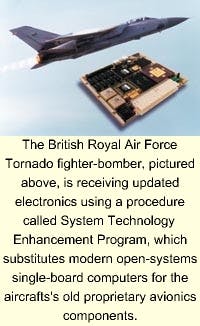By John McHale
The British Royal Air Force Tornado fighter-bomber, pictured above, is receiving updated electronics using a procedure called System Technology Enhancement Program, which substitutes modern open-systems single-board computers for the aircrafts's old proprietary avionics components.
KANATA, Ontario — Engineers at DY 4 Systems Inc. of Kanata, Ontario, used their System Technology Enhancement Program (STEP) to upgrade the U.K. Royal Air Force Tornado aircraft's missile management system. DY 4 officials claim their STEP program provides a bridge for old avionics designs to run on commercial-off-the-shelf COTS) hardware.
STEP will help military leaders avoid the high costs of reengineering relatively old systems and enable systems designers work with state-of-the-art technology, says Duncan Young, director of marketing at DY 4.
The program is a formalized and enhanced version of DY 4's life cycle management capabilities. It is a methodology that leverages the best of today's open-architecture COTS technology to fit within existing military systems that — until now — could not accommodate off-the-shelf products, DY 4 officials say.
For the Tornado, DY 4 engineers used the STEP program to design a reformatted rugged COTS single-board computer — the DY 4 CCA-101 — for the aircraft's old avionics system.
DY 4's STEP program enables the old avionics systems to change mission profiles cost-effectively and prepare for ever-changing enemy threats, DY 4 officials say. Aircraft such as the Tornado, U.S. Navy F-14 Tomcat jet fighter, U.S. Air Force F-16 fighter and B-52 bomber have relatively old avionics.
Through STEP and wise budgeting, avionics designers can re-engineer existing line replaceable units (LRUs) to take advantage of the growth potential and technology insertion benefits that open architectures offer, Young explains.
Often, engineers redesign or replace old military electronics to keep pace with technology advancement, or when maintenance becomes too costly. However, many of today's systems came to be before procurement reform, and have old proprietary architectures that make COTS-based upgrades difficult, Young says.
Many of the systems that deployed 10 to 15 years ago were designed to deal with now-outdated scenarios, Young says. That old hardware is not easily upgradeable in a plug-and-play sense, and much of the old software code is not widely used today, he explains.
DY 4 engineers focus on modularity when they design the replacement board and, and consider open-architecture concepts such as VMEbus or CompactPCI, Young says. Vendors then can deliver COTS hardware and software to fit existing old LRUs, thereby extending their useful life, upgrading their performance, and increasing their flexibility, DY 4 officials explain.
Starting with standard off-the-shelf hardware can enable engineers to develop software quicker than ever before, Young says, and then can migrate quickly to a reformatted target board. STEP not only upgrades old systems to match those of current, high-performance commercial technologies, but also readies them for their next inevitable performance step-up, they explain.
One of DY 4's software partners is TRW in Redondo Beach, Calif., Young says. TRW engineers have developed an object-based software program called REPLACE — short for reconfigurable processor for old avionics code execution — to run old code on PowerPC processors, he explains.
DY 4 officials claim STEP boosts re-engineered LRU performance because it enables standard product design modules to use open-systems processors, low-risk off-the-shelf software-development tools, languages, and operating systems.
For the STEP program to be a success, systems engineers must use technology insertion methods when they replace old modules, Young says.

